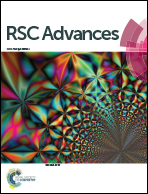Synthesis and electrochemical performance of Na-modified Li2Fe0.5Mn0.5SiO4 cathode material for Li-ion batteries
Abstract
A series of Li2−xNaxFe0.5Mn0.5SiO4/C (x = 0.00, 0.01, 0.03 and 0.05) composites have been synthesized via a refluxing-assisted solid-state reaction, and characterized by X-ray diffraction (XRD), scanning electron microscopy (SEM), X-ray photoelectron spectroscopy (XPS), galvanostatic charge–discharge measurements, cyclic voltammetry (CV) and electrochemical impedance spectroscopy (EIS) tests. XRD results show that Li2−xNaxFe0.5Mn0.5SiO4/C can be well indexed as the structure of two mixed polymorphs with space group P21 and Pmn21. XPS results confirms that Na not only exists on the surface of Li2Fe0.5Mn0.5SiO4 particles, but also has been successfully doped into the crystal lattice of Li2Fe0.5Mn0.5SiO4. Na-doping can significantly improve the discharge capacity and the rate capability of Li2Fe0.5Mn0.5SiO4/C. The enhanced electrochemical performance can be attributed to the increased electronic conductivity, the decreased charge transfer impedance, and the improved Li-ion diffusion coefficient.


 Please wait while we load your content...
Please wait while we load your content...